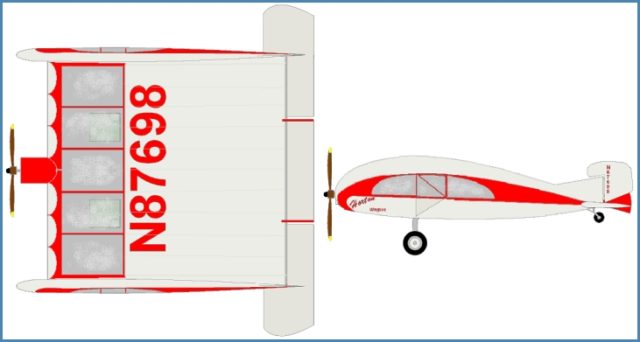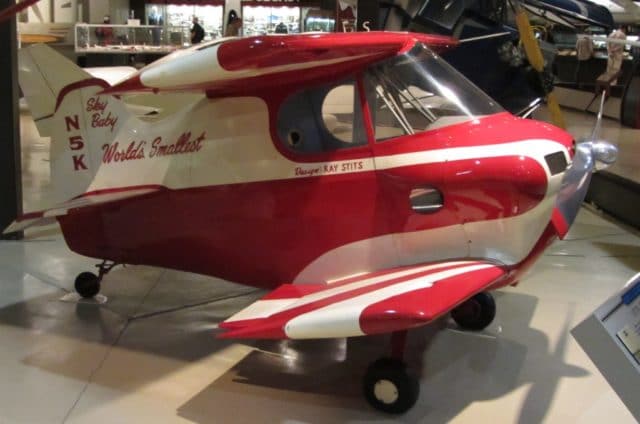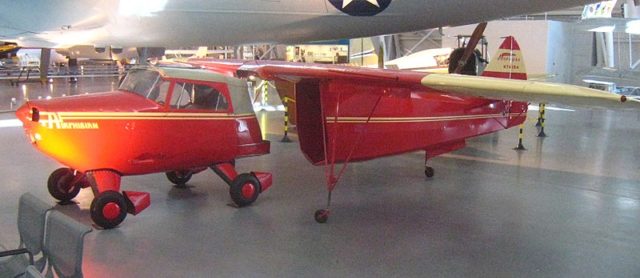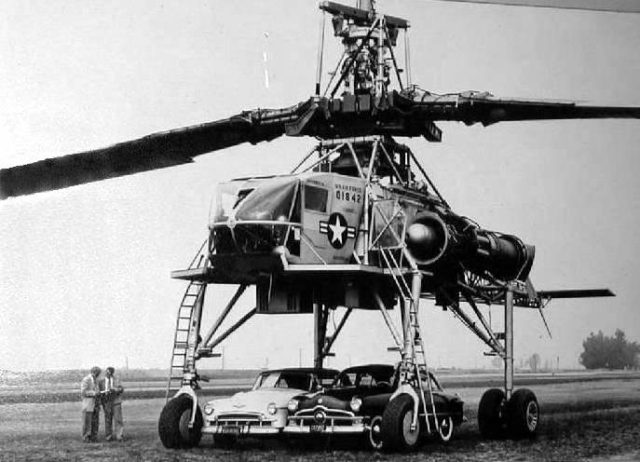The Latest Futuristic and Experimental Aircraft in 1952
This week I’m going to share a great video with you which has only just come to my attention. It’s a 1952 newsreel showing the latest futuristic and experimental aircraft.
The video includes the Horton Wingless Airplane, the Sky Baby, the Fulton Airphibian and the XH-17 Flying Crane. I’ve collected some more information on each of these for you because I know that, like me, you’ll want to find out more!

The Horton Wingless Aircraft never made it off the ground…whether that’s literally or not, though, depends on who you ask! The sad story is explained in this Aerospace Legacy Foundation document with some details on Horton’s unfortunate partnership with billionaire Howard Hughes.
The plane was test-flown but not more than 1000 feet down the runway. The venture failed not because the airplane didn’t fly, but because Hughes wanted to take full credit for the patents and production rights, which Horton refused to allow. Hughes sued Horton which effectively stopped any further development of the aircraft.
Hughes managed to have the prototype and partially-constructed production version destroyed. One aspect of the law suit was a statement that the aircraft could not fly, which witnesses, photographs and video obviously show not to be true. At one point, Horton served jail time for selling stock in a company for an airplane that “couldn’t fly” and had several violent confrontations with people associated with Hughes and Curtis because of the law suit and resulting injunctions.

The Sky Baby, designed by Ray Stits, has to be the cutest plane I’ve ever seen. Bangshift has a fun article about the designer, Ray Stits, who couldn’t fly in the aircraft he designed because he weighed too much!
We’re not sure what caused Ray Stits to focus in on building the world’s smallest functional airplanes, but he sure did and built his first craft, called the Stits Jr in 1948. This was a miniscule airplane but amazingly, it was the biggest of the miniatures he produced (Stits was also involved with the production of some full sized aircraft as well). With a wingspan of 8′ 10″ and a total length of 11′ the airplane weighed only 398lbs without a pilot wedged into its 16″ wide cockpit. The 85hp Continental engine powered the airplane to speeds of up to 170mph and Bob Starr flew it some 3,300ft in the sky during several test flights. The creepy fact is that the plane only had a gas tank that held 4.5 gallons. It had a takeoff speed of 60mph.

The Fulton Airphibian was the first “roadable” aircraft to be certified as airworthy, having received a Civil Aeronautics Authority Approved Type Certificate in 1950. After landing, the pilot simply needed to disengage the wings, tail and the propeller for it to become a car. The son of Frazer Dougherty, the first test pilot, has created a basic website to collect the stories and photos of all those involved with the Airphibian. It is a bit rough and ready but there’s some good information there.
During the evening Bob [Fulton] related his flying experience and the development of his auto/plane idea. After several telephone calls and letters, Frazer made the first flight of the AIRPHIBIAN off a small grass airstrip just west of Middleburg, Va. This remote, relatively unknown and unused ‘strip’ (although just south of route 7) was chosen due to Bob’s ‘secrecy’ phobia. It was probably the dumbest step taken in the entire project as there was no place to go except up. It was during this session that we (Bob, Wayne, Ted and I) all met for the first time and successfully flew the AIRPHIBIAN, the first auto/plane .

The 30-foot-tall Hughes XH-17 was the first helicopter project for the helicopter devision of Hughes Aircraft Company. Air & Space magazine has a great feature on the weirdest looking helicopter I’ve ever seen.
The XH-17 was born when the Air Force contracted with Kellett Aircraft to develop a massive helicopter to lift vehicles, artillery, and supplies across rivers, swamps, and mountains. Distinguished by its giant main rotor—each of the two blades was 5,000 pounds, 12 inches thick, and nearly six feet wide—the helicopter had a propulsion system that routed compressed air from two jet engines to the blade tips: there the air mixed with fuel and the mixture ignited to generate thrust. The resulting pinwheeling spun the giant rotor. “A 130-foot [diameter] rotor at the time was just inconceivable,” the XH-17 project engineer Nick Stefano later wrote to fellow engineer Ray Prouty, who compiled an archive of letters, photos, and pilot reports on the project.
I’m fascinated by these early prototypes; somehow they look so much more approachable than modern experimental planes. Certainly, I’d be happy to have a Sky Baby all my very own or the Fulton Airphibian, for that matter. I’m not sure about the XH-17 though — the name just doesn’t have the same sort of ring to it!








That helicopter is pretty crazy, it weighs so much! I just read “The Bell Notes” by Arthur Young, a collection of notes he made while working developing a line of full sized helicopters based on his models and research of over 10 years, it was really interesting. Thanks for a great video.
https://www.amazon.com/Bell-Notes-Arthur-M-Young/dp/0960985042
I don’t know about the “Sky Baby”, but it reminds me of the GeeBee.
Similar shape albeit different size.
The problem with the GeeBee was that due to the very short fuselage is was extremely difficult to control, especially at low speeds.
I believe that it crashed during a high speed run or race, probably because of a fuel filler cap detaching itself and flying through the windscreen.
Many projects from the “golden era of aviation” which I reckon was just before WW 2 were very innovative.
A flying car still is not a reality. So many rules and regulations. Even if the owner removes the wings, that does not make an aircraft road-legal (Sylvia recently had an entry about that).
Which reminds me of a cartoon from at least 15 if not 20 years ago: It showed a large jet transport with its nose nearly hitting the roof of an old-style pub.
Parked at the door of the pub, just under the nose of the jet, is a small van with the sign: “Follow me”.
A number of “flying cars” have been invented and built over the years; they never became a commercial thing, for all the obvious reasons:
1) Being half one thing and half another, they aren’t as good in either role.
2) Between curves, traffic, potholes, and overhanging lights and signs, roads really aren’t very good runways.
3) Both sorts of regulatory agencies tend to have conniptions (and you’d need both licenses).
4) Look around you on the roads. How many accidents and near accidents do you see or hear about, from drunk/drugged drivers, teenagers showing off, drivers eating, doing makeup, sending E-mail and the like (in all combinations)? Do you really want all those idiots crashing into skyscrapers, or through your roof?
I recall as a small boy seeing the “Fairey Rotadyne” at a Farnborough air show back in the ’50s. I believe that it used compressed gas from jets at the rotor tips to turn the blades, as did the XH-17. The noise was awesome and probably led to the demise of this promising looking aircraft.
If the XH-17 is the weirdest helicopter you have ever seen, then you haven’t seen the Isacco I-4. This was an attempt to do the same thing – build a giant helicopter with power generated at the blade tips – except that as jet engines hadn’t been invented the machine had FOUR PISTON ENGINES to drive the blades, one at each end! They only tried to run it once, with disastrous results: one of the tip-mounted engines snapped off and flew away.
The Sky Baby was simply a record attempt to build the smallest airplane in the world. Ray Stits was successful. It held the record for smallest airplane until the pilot of Sky Baby, Bob Starr built and even smaller plane called Bumble Bee.